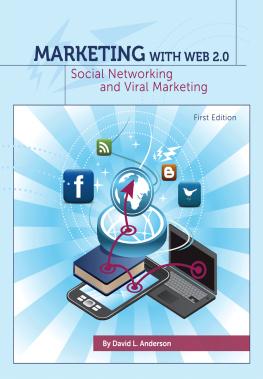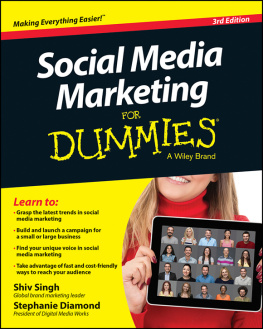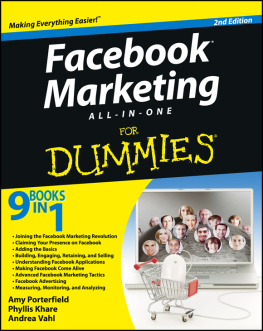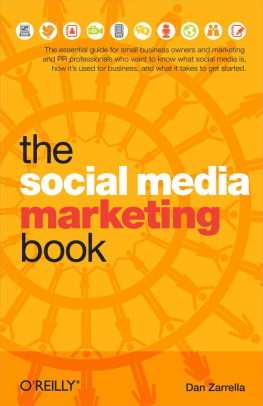David L. Anderson - Marketing with Web 2.0: Social Networking and Viral Marketing
Here you can read online David L. Anderson - Marketing with Web 2.0: Social Networking and Viral Marketing full text of the book (entire story) in english for free. Download pdf and epub, get meaning, cover and reviews about this ebook. year: 2012, publisher: Cognella, Inc., genre: Politics. Description of the work, (preface) as well as reviews are available. Best literature library LitArk.com created for fans of good reading and offers a wide selection of genres:
Romance novel
Science fiction
Adventure
Detective
Science
History
Home and family
Prose
Art
Politics
Computer
Non-fiction
Religion
Business
Children
Humor
Choose a favorite category and find really read worthwhile books. Enjoy immersion in the world of imagination, feel the emotions of the characters or learn something new for yourself, make an fascinating discovery.
- Book:Marketing with Web 2.0: Social Networking and Viral Marketing
- Author:
- Publisher:Cognella, Inc.
- Genre:
- Year:2012
- Rating:4 / 5
- Favourites:Add to favourites
- Your mark:
- 80
- 1
- 2
- 3
- 4
- 5
Marketing with Web 2.0: Social Networking and Viral Marketing: summary, description and annotation
We offer to read an annotation, description, summary or preface (depends on what the author of the book "Marketing with Web 2.0: Social Networking and Viral Marketing" wrote himself). If you haven't found the necessary information about the book — write in the comments, we will try to find it.
This text is directed toward individuals who want to incorporate new technologies into their marketing portfolio or are looking for new methods to reach the next generation audience.
Marketing with Web 2.0: Social Networking and Viral Marketing — read online for free the complete book (whole text) full work
Below is the text of the book, divided by pages. System saving the place of the last page read, allows you to conveniently read the book "Marketing with Web 2.0: Social Networking and Viral Marketing" online for free, without having to search again every time where you left off. Put a bookmark, and you can go to the page where you finished reading at any time.
Font size:
Interval:
Bookmark:
Marketing with Web 2.0: Social Networking and Viral Marketing
By David Anderson
Westmont College
Bassim Hamadeh, Publisher
Christopher Foster, Vice President
Michael Simpson, Vice President of Acquisitions
Jessica Knott, Managing Editor
Stephen Milano, Creative Director
Kevin Fahey, Cognella Marketing Program Manager
Al Grisanti, Acquisitions Editor
Jamie Giganti, Project Editor
Brian Fahey, Licensing Associate
Copyright 2013 by Cognella, Inc. All rights reserved. No part of this publication may be reprinted, reproduced, transmitted, or utilized in any form or by any electronic, mechanical, or other means, now known or hereafter invented, including photocopying, microfilming, and recording, or in any information retrieval system without the written permission of Cognella, Inc.
First published in the United States of America in 2012 by Cognella, Inc.
Trademark Notice: Product or corporate names may be trademarks or registered trademarks, and are used only for identification and explanation without intent to infringe.
Printed in the United States of America
ISBN: 978-1-62131-407-3

Chapter 1
A Changing Media Landscape
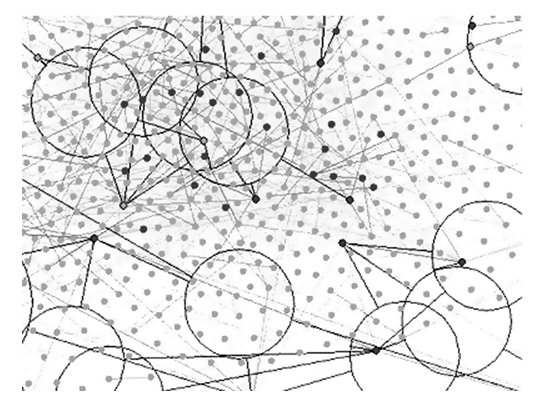
Introduction
The turn of the century has brought with it an explosion of different media formats. Such a vast acceleration in options has created a new kind of consumer. Todays consumers spend the majority of their waking hours interacting with others via web-based technologies. Instead of depending on traditional avenues for information, consumers are relying on instant access to informal and often unprofessional web-based venues. Consumers are discovering their own music, making their own videos, blogging their own opinions, and reading news from their own political persuasion. The result is the emergence of the independent and individualized consumer.
Marketers who wish to rise to the occasion are meeting the consumer on his or her own playing field. There has become a new demand for businesses to create an online presence through web-based technologies focused on social networking and viral marketing. Instead of focusing on only the former staples of construction and manufacturing, businesses now emphasize analysis, consolidation, and the integration of data. There is a critical need to understand and listen to consumer now more than ever.
Case Study: Interactive Mobile Technologies
The last decade has seen a rapid adoption of technology and the displacement of more traditional media. Technologies such as Tivo, the iPod, iPad, iCloud, and blogs enable consumers to put together their own customized news streams. Media consumers now live in their own bubbles, where the news they consume is different from that of their neighbors, both in terms of focus and political slant. While liberating consumers to make their own choices, the flipside of this trend is an end to the old waysand standardsof journalism. It also means that individuals can focus their news and music to continue to refine their listening patterns to the targeted exclusion of every other pattern.
Chapter 1 examines the impact of this technology, including the Internet, on media consumption. Chapter One explores the following trends:
- Increase in choice and customization (accomplished by cable television, online news, and clearly defined news selection).
- Increase in consumption hours (individuals are using technology more extensively and in more places, leaving access running all the time).
- Increase in speed of the news cycle (for example, the output of a professional newspaper columnist like Mike Royko was five columns a week. Blogger Andrew Sullivan posts constantly day and night).
- Increasing competition among advertisers for consumers eyeballs and attention (new approaches and gimmicks to capture attention and keep individuals interested).
- The rise of the amateur content developer and the end of paid content (resulting in the mindset of if hobbyists are developing and distributing content for free, why should anyone pay for anything?)
- The democratization of the media (within the media, the amateur is on the same level as the expert. Bloggers break stories and gain journalistic credentials. With reduced advertising, newspapers are not able to afford full-time journalists. A cheapening of production methods makes it easier for entry-level individuals look legitimate and gain an audienceno one knows you are just starting out).
- Customization and isolation leads to the bubble effect (i.e., we feel comfortable getting our news from increasingly tailored/slanted sources, changing the nature and civility of the discourse because of this sense of isolation).
- The decline of serendipity. (When do people get a chance to think for themselves instead of consuming media? Is it only when they are blogging/tweeting that they are not actually consuming media? How much are people influenced by the bloggers/tweeters they trust?)
In the 1950s, consumers found out about new music by watching TV shows like American Bandstand, listening to Top 40 radio, going to record stores, or listening to music at friends houses. If you liked a song a nd wanted to hear it again, you had to wait for the radio station to play it again.
Viewed through the lens of history, the changes to the media landscape in the 20 th and 21st centuries have accelerated at an astounding speed. In the 1700s, only a few people could read. If they were fortunate enough to read, they owned one book. When people in the 1890s wanted to hear music, they had to play it themselves. One constant in the Western media is that the number of choices and options is constantly increasing. Before the Internet, radio went from AM to FM. Music went from live performances to the radio to the phonograph. Then music rapidly moved from the phonograph to the 8-track, to tapes, CDs, and MP3 players. Benjamin Franklins newspaper was weekly. Then newspapers became daily, twice daily, several editions a day, to our current 24-hour news sources. Movies moved from the theater to the home to the portable DVD player to the iPod.
With the increase in media formats, options are available for almost every occasion. The amount of media being consumed has increased as well. Americans now spend multiple hours each day consuming media, often multitasking while doing so. They spend time in front of the television and the laptop, with the iPod, and on the iPhone. Computers are an integral part of every room in the house.
Americans no longer live a 24-hour day. We spend almost 10 hours a day consuming media, according to the Census Bureau. When that time is spent multitasking, and not concurrently, the average day can extend to 49.7 hours, not just 24. This includes work for 7.5 hours, commute for 1.4, eat for 1.8, sleep for 6.9, spend 4.5 hours with family, 1.8 hours with friends, 3.7 hours using the Internet, 3.6 hours watching television, 2.2 hours listening to the radio, .5 hours reading, and 15.8 hours IMing, texting, listening to mp3s, playing video games, e-mailing All together, it stretches to 49.7 hours.
The amount of media being produced, as a result, has risen to meet this demand. As noted earlier in this chapter, prolific newspaper columnist Mike Royko produced five columns per week during the 1960s. Today, the political blogger Andrew Sullivan writes constant blog posts each week, in addition to many stories for a number of different magazines.
Journalism is expensive to research, fact-check, and report. With the increase in the amount of news being produced and the move to a 24-hour news cycle, the type of news written, its accuracy, and its distribution has changed. Traditional journalism has been largely replaced by interviews, commentaries, and opinion, which is cheaper than investigatory journalism and on-the-ground reporting.
Next pageFont size:
Interval:
Bookmark:
Similar books «Marketing with Web 2.0: Social Networking and Viral Marketing»
Look at similar books to Marketing with Web 2.0: Social Networking and Viral Marketing. We have selected literature similar in name and meaning in the hope of providing readers with more options to find new, interesting, not yet read works.
Discussion, reviews of the book Marketing with Web 2.0: Social Networking and Viral Marketing and just readers' own opinions. Leave your comments, write what you think about the work, its meaning or the main characters. Specify what exactly you liked and what you didn't like, and why you think so.

